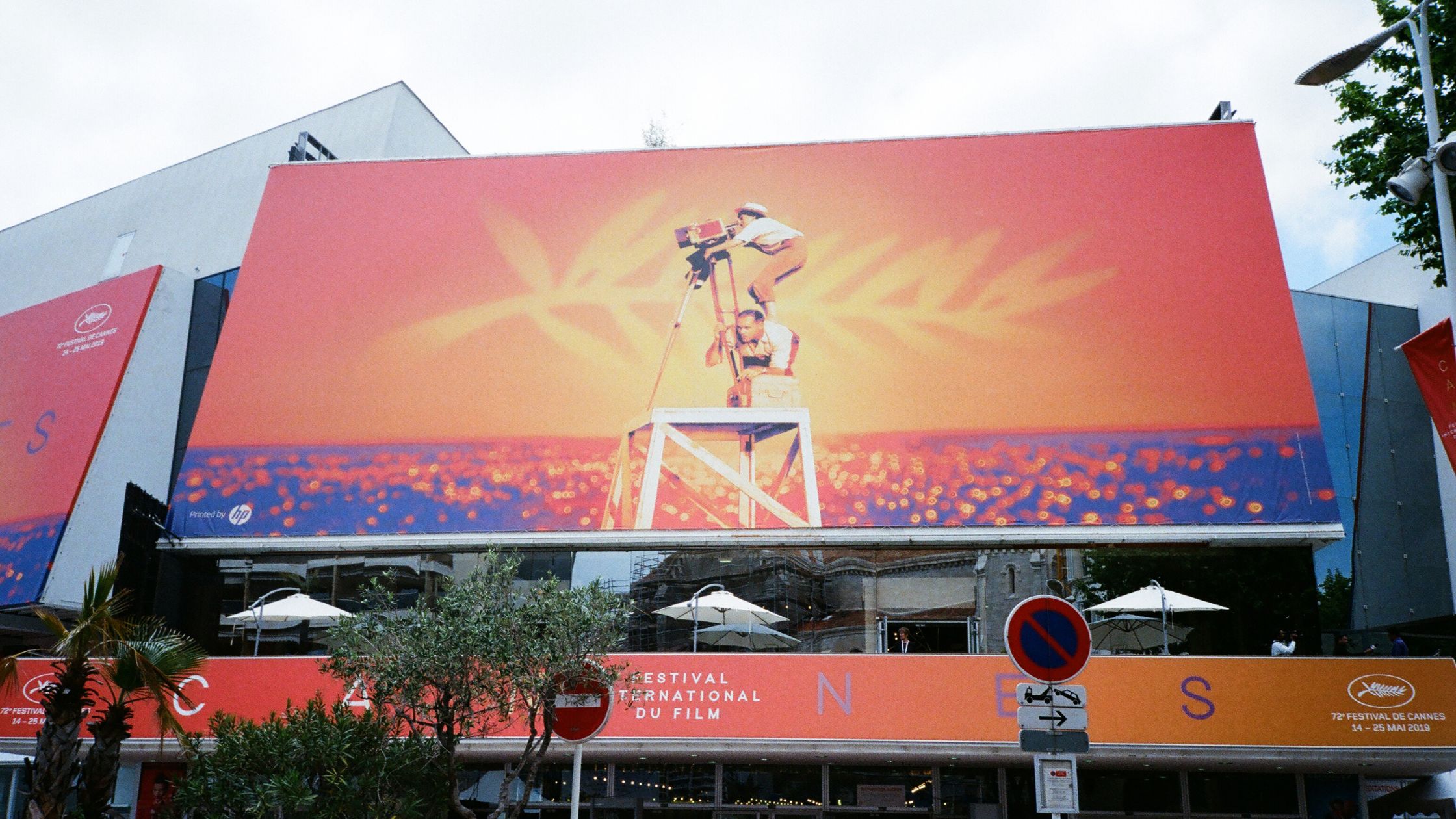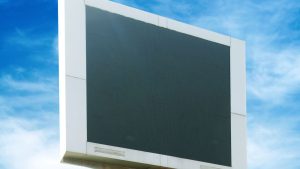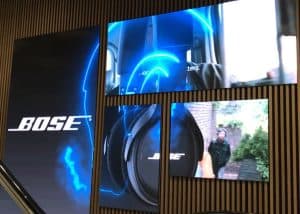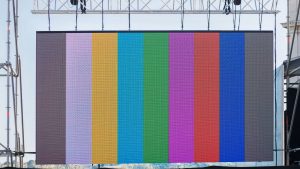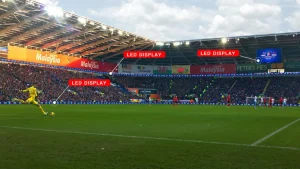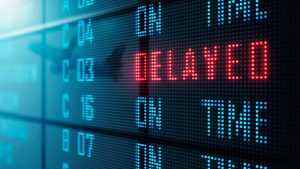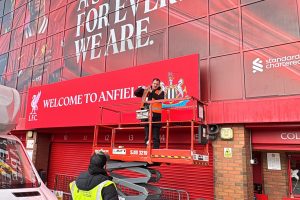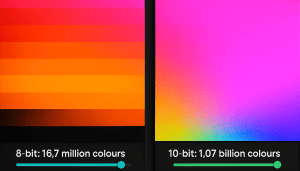With prices more accessible than ever, LED screens are lighting up spaces from cozy coffee shops to bustling outdoor arenas. Whether you’re aiming to captivate passersby with a giant billboard or add flair to your home entertainment setup, understanding what goes into the cost of an LED display can help tailor the perfect solution for your needs.
Costs can vary widely, influenced by everything from the size and specs of the screen to the intended use—be it indoor calm or outdoor chaos.
Are you wondering if LED displays are worth the recent hype or not? Let’s find out.
In this article, we’ll focus on breaking down the prices and factors that shape the cost of LED displays, helping you make an informed decision that matches both your vision and your budget.
How Much Does an LED Display Cost?
The price of LED displays can range widely, from a few thousand to several hundred thousand British pounds, depending on factors such as size, pixel pitch, and type.
For instance, simple indoor screens might start around a few thousand pounds, while expansive outdoor billboards could escalate to hundreds of thousands.
Prices per square meter can fluctuate dramatically, often ranging from under £1,000 to over £15,000 for ultra-high-resolution or specially designed models.
What Factors Affect the Cost of LED Displays?
The cost of LED displays requires analyzing various factors that directly influence pricing. These factors include pixel pitch, screen resolution, size, viewing distance, type, and purpose of the display, whether it’s intended for indoor or outdoor use.
Additional variables like frame material, the brand and quality of components, installation type, and extra features such as brightness and refresh rate also play significant roles.
Furthermore, logistical aspects such as shipping, mounting, maintenance, power consumption, and even the location or market conditions can affect the final price.
Pixel Pitch
Pixel pitch is a critical factor affecting the cost of LED displays, with smaller pitches typically costing more due to the higher density of LEDs. For outdoor displays, a P4mm pixel pitch might range from £648 to £766 per sqm, while a larger P10mm pitch could cost between £410 and £455 per sqm. For high-resolution needs, prices can escalate, exceeding £2,000 per sqm for very fine pitches.
Screen Resolution
The resolution of an LED screen is directly proportional to its cost. Higher resolutions mean more LEDs are needed per square meter, increasing the price.
For example, high-resolution fine pitch screens such as P1.5 can cost around £2,400 per sqm. When considering 4K resolutions or higher, the density of LEDs increases significantly, further driving up the cost.
Screen Size
The size of the LED display greatly impacts the price due to the increased material, production, and installation requirements. Small outdoor LED displays under 100 sq ft can cost between £5,000 and £15,000, while medium-sized displays of 100 to 300 sq ft range from £15,000 to £50,000. Large displays over 300 sq ft can reach from £50,000 up to several hundred thousand, with costs scaling with both size and complexity of installation.
Viewing Distance Requirements
The required viewing distance for an LED display directly influences its pixel pitch, which in turn affects the cost. A closer viewing distance necessitates a finer pixel pitch, increasing the overall expense.
For example, a P5 pixel pitch, optimal for viewing distances of 5 to 15 meters, is typically more costly than a P10 pixel pitch, which is best viewed from 10 to 30 meters. Selecting the appropriate pixel pitch for the intended viewing distance can prevent overspending on unnecessary resolution, thus optimizing the budget for LED displays.
LED Display Type
The type of LED display—whether outdoor fixed, indoor fixed, rental, transparent, or curved—significantly varies in cost due to the materials and technology used.
Rental LED displays often use lighter, more expensive die-cast materials and require smaller pixel pitches, ranging in price from approximately $800 to $1,300 per square meter. Conversely, indoor displays are generally less expensive than their outdoor counterparts by about $150 to $500 per square meter.
Transparent LED screens, offering varying levels of pitch and transparency, can cost anywhere from $600 to $2,500 per square meter.
Purpose
The intended purpose of an LED display impacts its cost, particularly in terms of brightness and environmental protection requirements. Indoor displays typically have lower brightness levels and thus cost less, whereas outdoor displays require higher brightness (at least 7000 nits) and robust weatherproofing, increasing their cost.
Additionally, displays designed to withstand extreme environmental conditions such as high heat or high humidity will incur higher costs due to the need for specialized materials and technology to ensure longevity and performance under these conditions.
Frame Material
The choice of frame material affects both the cost and the durability of LED displays. Common materials include steel, aluminum, magnesium alloy, and die-cast aluminum, each with different cost implications.
Steel frames are the cheapest but are heavier, which might increase installation costs.
Aluminum frames offer a lighter alternative at a higher price point. More expensive materials like carbon fiber or magnesium alloys provide significant weight reductions at a higher cost but can offer long-term savings in terms of maintenance and energy efficiency.
Brand and Quality of Components
The quality and brand of components significantly impact the cost of LED displays. LED lamps and integrated circuits (ICs) vary in price, which can alter the overall cost of an LED display by 5–50%. High-quality power supplies and ICs, while initially more expensive, reduce long-term maintenance costs and minimize the occurrence of dead pixels. Therefore, investing in reputable brands and high-quality components not only ensures the longevity of the display but also optimizes performance, making it a critical factor in cost evaluation.
Installation Type
The type of installation also plays a crucial role in determining the cost of an LED display. Fixed installations are generally more cost-effective compared to rental options.
However, front-serviceable designs, although pricier initially, can offer savings on structural costs in the long run. Additionally, certain installations may require special mounting solutions, which can further increase the expense.
Are There Extra Features That Add to Costs?
Extra features can significantly increase the cost of an LED display. Features such as higher brightness levels, higher refresh rates (such as 1920Hz or 3840Hz), moisture-proofing, and custom shapes require advanced technology and materials, thereby raising the price. Special protective coatings and advanced weatherproofing options, along with sophisticated control systems, also contribute to the overall cost.
Transportation and Shipping Costs
The method of shipping contributes to the cost of LED displays. Sea freight, while slower, is considerably cheaper than air freight and is chosen by approximately 70% of buyers due to its cost-effectiveness.
However, the total shipping costs can vary significantly, ranging from door-to-door express delivery for items under 100kg to large freight options.
Additionally, import taxes and customs clearance also add to the final price, making it important to factor these costs into the budget, especially for international projects.
Mounting and Installation Costs
The complexity of mounting and installation significantly impacts the overall cost of LED displays. Difficult installation locations, such as high elevations or areas with limited access, necessitate specialized equipment and skilled labor, thereby increasing costs.
Professional installation can add thousands to the budget, particularly for large or intricate displays.
Conversely, opting for self-installation for smaller setups can substantially reduce expenses, though this may not be viable for all projects due to technical challenges and the need for precision.
Maintenance and After-Sales Services
Effective maintenance and robust after-sales services are essential for the longevity of LED displays but can also add to their total cost.
Annual maintenance is recommended to ensure optimal functioning, involving cleaning and the replacement of essential components like power supplies and LEDs.
The availability of spare parts and the presence of reliable after-sales support are crucial; their absence can lead to escalated repair costs over the display’s lifespan.
Power Consumption
Power consumption is a critical cost factor for LED displays, typically ranging from approximately 0.3 to 0.8 kW per square meter per hour. For example, a P10 outdoor LED display may consume up to 950W per square meter at peak operation.
Over time, this energy usage translates into significant operating costs. Investing in more efficient components, although potentially more costly upfront, can result in substantial long-term savings on electricity bills.
Market and Location
The market and location of the LED display installation play a crucial role in determining costs. High-traffic areas often have stringent regulations that can increase both installation and rental fees.
Conversely, urban centers with a higher concentration of suppliers might offer more competitive prices due to better availability and more intense market competition, potentially lowering costs.
Refresh Rate
The refresh rate of an LED display affects its suitability for different applications and its cost. Higher refresh rates, such as 3840Hz or more, are necessary for applications like live broadcasting, where reducing screen flicker is crucial. However, these high refresh rates require advanced technology, increasing the cost of the display.
Brightness Levels (Nits)
Brightness levels significantly influence the cost of LED displays. Outdoor displays require higher brightness, typically over 7,000 nits, to remain visible in bright sunlight, thus driving up costs due to the need for more powerful LEDs.
Indoor displays, on the other hand, can operate effectively at lower brightness levels (about 700 to 1,000 nits), which reduces their cost compared to their outdoor counterparts.
Lifespan and Durability
The lifespan and durability of LED components are critical factors affecting initial investment and ongoing maintenance costs.
High-quality LEDs and stable Integrated Circuits (ICs) may cost more upfront but tend to have longer life spans and lower maintenance needs over time. Conversely, cheaper products may fail sooner, increasing the frequency and cost of replacements and repairs, thereby escalating the total cost of ownership.
Customization Options
Customization can significantly affect the cost of LED displays. Custom shapes like circular, curved, or transparent LED displays require specialized materials and assembly processes, increasing costs.
For example, a circular LED display may range from £2,500 to £5,100 per square meter depending on the complexity and size, reflecting the premium for bespoke design and manufacturing.
Control System Compatibility
The complexity of the control systems also plays a crucial role in determining the cost of LED displays. Sophisticated synchronous, asynchronous, Wi-Fi, or 4G control systems enhance functionality but add to the cost. Larger displays requiring advanced video processors and high-end controllers further amplify the expense, necessary for managing extensive and high-resolution visuals effectively.
Environmental Factors
Environmental considerations such as weatherproofing and UV resistance also impact the cost. Displays installed in harsh weather conditions require IP65 or even IP68 ratings to ensure durability, significantly increasing their price. Additionally, UV-resistant coatings and adaptations for extreme environmental conditions like deserts or seaside locations add to the complexity and cost of the display units.
Modular Design and Flexibility
Modular LED panels offer benefits in terms of maintenance and flexibility but come with a higher initial cost. These designs allow for easier upgrading and replacement of parts, which can lead to cost savings in the long term. Additionally, features like rental-friendly locks and flexible modules, which provide more installation options, also add to the upfront cost but may offer savings through versatility and reduced future expenditures.
Manufacturing Origin and Supply Chain Factors
The cost of LED displays is significantly influenced by the manufacturing origin and supply chain logistics. The origin of materials and the location of assembly play crucial roles in the overall cost, as import taxes and customs clearance can add substantial overhead.
Moreover, shipping costs from specific regions can greatly affect the final price point, making the supply chain a vital factor in pricing.
Certification Standards (e.g., energy efficiency, safety regulations)
Adherence to certification standards also impacts the cost of LED displays. Compliance with energy efficiency and safety regulations can add to the initial price due to the higher quality and certified components required.
However, these components often offer longer lifespans and reduced operating costs, presenting a valuable trade-off for long-term savings.
Lead Time for Production and Delivery
The lead time for production and delivery can also affect cost. Urgent orders requiring accelerated production or delivery schedules often incur higher charges to meet the demanded timelines.
Conversely, allowing for longer lead times might enable cost savings on materials and shipping, benefiting budget-conscious projects.
Technology Used (e.g., SMD vs. DIP LEDs)
The type of technology used in LED displays affects their cost. Surface-Mounted Device (SMD) technology, which is typically used for finer pitches and both indoor and outdoor applications, can be more expensive, with costs ranging from £800 to £1,300 per square meter for fine pitch models.
On the other hand, Dual In-line Package (DIP) LEDs might be cheaper but are less refined in terms of resolution and appearance.
Spare Parts Availability
Finally, the availability of spare parts is a crucial factor in the cost of maintaining LED displays. Ensuring a readily available supply of spare modules, power supplies, and cables can increase the initial investment but significantly reduce long-term costs associated with downtime and maintenance.
What Are the Costs of Different LED Display Types?
Outdoor fixed installations often start at around £5,000, but prices can quickly escalate based on size and pixel pitch. Indoor displays, generally smaller and less robust than their outdoor counterparts, can start from a few thousand pounds.
Specialty displays, including rental configurations, transparent, 3D, and curved displays, present a wide range of prices due to their unique materials and manufacturing requirements.
For example, transparent LED screens typically range from £600 to £2,500 per square meter, whereas high-resolution fine pitch indoor displays might reach up to £2,400 per square meter.
Perimeter displays, often used in sports venues, vary in price depending on the length and environmental durability required.
How Much Does an Outdoor LED Screen Cost?
Outdoor LED screens come in various sizes and specifications, each catering to different viewing needs and environmental conditions, impacting their cost considerably.
Small Outdoor LED Billboards (Under 100 Square Feet)
Small outdoor LED billboards, typically under 100 square feet, range in price from £5,000 to £15,000. These screens usually utilize a P10 pixel pitch, costing approximately £410 to £507 per square meter.
The use of iron cabinets enhances waterproofing while keeping costs lower, making them a popular choice for small business advertisements and community messages.
Medium Outdoor LED Billboards (100–300 Square Feet)
For medium-sized outdoor LED billboards, covering an area of 100 to 300 square feet, the price ranges from £15,000 to £50,000. These often incorporate a P5 pixel pitch, providing a brightness of about 6500 nits, suitable for various outdoor lighting conditions. The adoption of die-cast aluminum cabinets facilitates easier installation and better heat dissipation, making them ideal for more extensive commercial use.
Large Outdoor LED Billboards (Over 300 Square Feet)
Large outdoor LED displays, particularly those exceeding 300 square feet, can cost upwards of £50,000 and may reach several hundred thousand pounds depending on the complexity and specifications.
These high-resolution, high-brightness displays (7000–10000 nits) are typically situated near highways or in prominent urban areas to maximize visibility.
What Is the Cost of Indoor LED Displays?
Indoor LED displays cater to a variety of environments, ranging from corporate lobbies to retail spaces, and their costs reflect their versatility and technological sophistication.
Fine pitch displays, which provide superior image quality at closer viewing distances, are at the higher end of the spectrum, typically costing upwards of £2,000 per square metre.
For example, a fine pitch P2 LED setup for a small area less than 10 square metres may cost between £8,000 and £30,000, depending on the complexity and integration of the system.
For more standard applications, such as in retail, a typical 3×2 metre indoor display complete with support structure might cost around £15,000. These displays usually offer brightness levels between 600–800 nits, adequate for indoor lighting conditions but not suitable for direct sunlight exposure, which influences their placement and utility in interior design.
How Much Do Transparent LED Screens Cost?
Transparent LED screens are particularly popular in retail windows and as partitions in commercial spaces. The cost for transparent LED screens varies:
- Standard Transparent Screens: Typically range from £600 to £2,500 per square metre, depending on the pixel pitch and the level of transparency. Indoor models with pixel pitches between P2.6 to P5.2 may cost between £1,200 and £2,200 per square metre.
- Outdoor Transparent Solutions: These are slightly more robust and are priced between £1,000 and £1,300 per square metre.
- Specialized Holographic and High-End Models: These can range from £1,500 to £3,000 per square metre, offering enhanced visual effects and integration capabilities.
What Are the Costs for Specialised Displays?
Specialized LED displays are designed for specific applications that require unique attributes not typically found in standard models. These include:
- 3D LED Displays: Small setups for dynamic advertising or entertainment start at £10,000, scaling up to over £200,000 for large installations in arenas or public spaces.
- Perimeter Displays: Used primarily in sports venues, these cost between £480 and £950 per square metre, influenced by the durability and pixel pitch required.
- Rental Displays: High demand for event-specific solutions leads to prices ranging from £800 to £1,300 per square metre, reflecting the premium for mobility and flexible use.
- Circular and Curved Displays: These are often custom-built and can cost anywhere from £2,500 to £15,000, depending on size and curvature, catering to niche markets that require bespoke solutions.
- Innovative Configurations: Including floor, ceiling, poster, interactive, and holographic displays, each with price increments based on the technology and installation complexity involved.
3D LED Screens
3D LED screens bring images to life with stunning depth and realism, often used in cinemas, advertising, and sophisticated installations. The cost of these displays can vary significantly:
- Standard Definition (10×20 ft): Costs for a standard definition 3D LED screen start from £10,000 and can go up to £50,000, catering to smaller venues or temporary installations.
- High Definition (20×40 ft): For a larger and more detailed display, prices range from £50,000 to over £200,000, suitable for permanent installations in malls or busy public areas.
- Very High-End Screens: Positioned in prime locations like major retail centers or outdoor public spaces, these screens can cost upwards of £200,000, offering unparalleled clarity and engagement.
Perimeter LED Displays
Perimeter LED displays are commonly seen around sports fields and arenas, designed to withstand various weather conditions and provide clear visibility from angles:
- Cost Range: These displays typically cost between £530 and £950 per square metre, depending on the specific technology and brightness requirements needed to combat direct sunlight.
- Durability and Brightness: Featuring adjustable brightness levels, these screens are robust, with P6.67 being a popular choice for its balance of cost and performance.
Rental LED Displays (Indoor and Outdoor)
Rental LED displays offer flexibility for events, exhibitions, and temporary installations, with costs reflecting their mobility and ease of setup:
- Cost Range: Generally, the rental cost for these screens ranges from £800 to £1,300 per square metre.
- Pixel Pitch and Size Considerations: Finer pixel pitches are preferred for high-profile stage events, increasing the rental cost. Larger screens required for concerts or festivals can accumulate costs into the tens of thousands.
Circular or Custom-Shape LED Screens
Circular or custom-shaped LED screens are often used for bespoke projects and artistic installations, providing unique visual experiences:
- Cost Details: A P1.5 circular LED screen of 1 metre in diameter may cost between £4,000 and £5,100 per square metre.
- Scaling Costs: Larger custom shapes and sizes see a proportional increase in costs, reflecting the complexity and additional materials required for non-standard configurations.
Flexible or Curved LED Screens
Flexible or curved LED screens represent a cutting-edge segment of display technology, designed to fit unique spatial requirements and aesthetic visions. These displays often require complex manufacturing processes to achieve their adaptable forms, which can significantly increase their cost. Typically, the price for these innovative screens can exceed standard flat models by hundreds of pounds per square metre, depending on the curvature and the complexity of the design. As such, they are frequently seen in high-profile venues like luxury retail environments, immersive installations, and innovative architectural projects where the visual impact justifies the higher investment.
Floor LED Displays
Floor LED displays are engineered for durability and the ability to withstand significant foot traffic. These displays are built with robust, load-bearing materials and are often protected by high-strength, impact-resistant top layers that can sustain continuous use in public spaces.
Due to these protective layers and the specialized materials required, floor LED displays typically carry a higher price tag compared to their standard counterparts. They are ideal for interactive advertising, exhibitions, and public installations where engagement with the display is encouraged.
Ceiling-Mounted LED Displays
Ceiling-mounted LED displays provide a unique viewing angle, offering new possibilities for space utilization and audience engagement in commercial and artistic venues. The installation of these displays involves specialized structures to ensure safety and stability, often leading to higher costs in both labor and the need for rigorous safety certifications.
These installations are particularly prevalent in malls, airports, and exhibition halls where they can offer directional information, advertising, and ambient visuals without occupying floor space.
Poster LED Displays
Poster LED displays are designed for versatility and ease of use, often utilized in retail, exhibitions, and indoor public spaces. These displays are portable and integrate seamlessly into various settings, typically featuring lower brightness levels that are suitable for indoor use, which helps to reduce their cost.
Prices for these units start from a few thousand pounds, making them an affordable option for businesses seeking dynamic display solutions without the extensive costs associated with larger installations.
Stadium or Sports Venue Displays
The cost for these installations typically starts in the tens of thousands of pounds and can easily escalate depending on the size, resolution, and complexity of the system. For a standard 10×20 ft scoreboard display with moderate specifications, prices can range from £10,000 to £50,000.
More advanced, high-definition displays in larger sports venues or those located in prime viewing areas may cost upwards of £200,000, reflecting their complexity and the high impact they deliver.
Interactive LED Displays (Touch-Enabled)
Interactive LED displays, which include touch-enabled screens, represent a rapidly growing segment in the display market. These displays incorporate additional sensors and touch layers that enable user interaction, making them suitable for educational, retail, and exhibition environments.
The inclusion of these advanced technologies can add several hundred pounds per square metre to the cost of the display. Prices vary based on the size, touch technology used, and resolution, often significantly exceeding the cost of standard LED displays due to the additional components and technology required.
Holographic LED Displays
Holographic LED displays, known for their ability to project floating 3D visuals, come at a premium due to the sophisticated technology involved. These displays typically range from £1,500 to £3,000 per square metre. The unique visual effects and the complexity of the technology that allows images to appear as if they are floating in mid-air contribute to the higher price point.
Transparent Grille or Mesh LED Screens
Transparent grille or mesh LED screens offer a solution that blends visibility with digital display capability, ideal for architectural installations where maintaining a view through the screen is important. These screens typically cost between £600 and £1,000 per square metre. Their use is particularly prevalent in building facades, large venue windows, and other applications where the screen should not completely block the background but rather complement the environment.
How Do You Calculate the Cost of an LED Screen?
To accurately estimate the cost of an LED screen, gathering comprehensive details is crucial. Here’s what you need to compile for an accurate quote:
- Dimensions: Exact width and height of the desired LED screen.
- Environment: Specify whether the display will be used indoors or outdoors, as this impacts the choice of materials and technology.
- Pixel Pitch: The distance between pixels, which affects resolution and viewing distance.
- Brightness: Required brightness levels, especially important for outdoor screens to ensure visibility in sunlight.
- Control System: Details about the desired control system, including whether it’s synchronous or asynchronous and any additional features like Wi-Fi or 4G capabilities.
- Shipping Method: The preferred method of shipping, which can affect the cost depending on speed and security.
- Installation Details: Include any installation drawings or specific requirements. This can impact the preparation work needed and the complexity of the installation.
- Maintenance Preferences: Whether you’ll need regular maintenance services from the supplier, which can affect long-term costs.
How Is the Cost per Square Meter Determined?
The cost per square meter of an LED display is influenced by several technical specifications that directly impact the manufacturing complexity and materials used. Here’s how key features affect the pricing:
- Pixel Pitch: A denser pixel pitch means more LEDs per square meter, significantly increasing the cost. Smaller pitch sizes provide higher resolution but require more LEDs and precision in manufacturing.
- Brightness: Higher brightness levels are essential for visibility in various lighting conditions, especially outdoors. Increasing the brightness typically involves using more powerful LEDs, which can raise the cost.
- Transparency Levels: For transparent LED displays, the level of transparency can affect the price. Higher transparency often requires specialized LEDs and manufacturing processes that can increase the cost.
How to Choose the Right LED Display for Your Budget?
When it comes to selecting an LED display within your budget, it’s essential to systematically evaluate all available options to ensure you get the best value for your investment. Here’s a step-by-step guide to help you navigate the process:
- Determine Size and Environment: First, assess the size of the LED display you need and the environment where it will be installed. Size will heavily influence cost, and environmental factors like indoor or outdoor use can determine the type of display technology (e.g., brightness and waterproofing) that’s necessary.
- Consider Pixel Pitch and Resolution: The pixel pitch, which affects the resolution, is crucial for determining the clarity and viewing distance of your LED display. A lower pixel pitch means higher resolution, ideal for close-range viewing but at a higher cost.
- Assess Feature Needs: Evaluate what additional features are necessary, such as touch capabilities, flexibility, or custom shapes. Each feature adds to the cost, so prioritize based on your specific needs.
- Compare Multiple Quotes: Obtain quotes from several suppliers to compare prices and options. Don’t just look at the initial cost; consider the quality and longevity of the displays as well.
- Total Cost of Ownership (TCO): Factor in the long-term costs of maintenance, spare parts, and energy consumption. An initially cheaper unit might end up being more expensive in the long run due to higher energy costs and frequent replacements.
What Are the Key Questions to Ask Before Buying?
Before committing to an LED display purchase, it’s crucial to ask specific questions to ensure that the product meets your expectations and requirements. Here are some essential questions to consider:
- Pixel Pitch and Brightness: What is the pixel pitch of the LED display, and how does it influence the viewing distance and clarity? Also, ask about the brightness levels, especially if the display will be placed outdoors, to ensure it remains visible even in direct sunlight.
- Warranty and After-Sales Support: What does the warranty cover, and how long does it last? Also, inquire about the type of after-sales support offered. This can include maintenance, technical support, and spare parts availability.
- Installation and Operating Costs: How complex is the installation process? Will you need to hire professionals, and what are the associated costs? Additionally, ask about the expected energy consumption and ongoing operating costs.
- Environmental Suitability: Is the display suitable for the environmental conditions it will be exposed to? For example, does it need to be waterproof for outdoor use or have a high brightness level for visibility in bright areas?
- Customization and Upgrades: Can the display be customized to fit specific dimensions or shapes? What are the costs associated with customizations? Also, inquire if future upgrades are possible and at what cost.
How to Get the Best Price for an LED Display?
Securing the best price for an LED display involves more than just looking at the initial cost. Here’s how you can ensure you’re getting the best deal:
- Compare Multiple Suppliers: Don’t settle on the first quote you receive. Comparing offers from various suppliers can reveal a range of prices and options, allowing you to negotiate better terms.
- Standard Pixel Pitches: While custom solutions are available, standard pixel pitches often come at a lower cost due to mass production benefits.
- Volume Discounts: If you are ordering multiple units, ask for volume discounts. Suppliers often reduce prices for bulk purchases.
- Optimal Shipping Options: Shipping can significantly affect the overall cost. Look for the most cost-effective shipping method without compromising the safety and integrity of the LED displays.
- Total Cost of Ownership (TCO): Consider not just the purchase price but the total cost of ownership, which includes maintenance, spare parts, and energy costs over the lifespan of the display. A cheaper upfront cost might not be the best deal if it leads to higher ongoing expenses.
What Information Should You Provide for a Quote?
To obtain an accurate quote for an LED display, you should provide comprehensive details to the supplier. Here’s what you need to include:
- Exact Dimensions: Specify the width and height of the display to ensure the quote meets your spatial requirements.
- Viewing Distance: The distance from which the audience will view the display helps determine the suitable pixel pitch.
- Environment: Indicate whether the display will be used indoors or outdoors, as this affects the type of display needed.
- Brightness: Required brightness levels depend on the location and lighting conditions where the display will be installed.
- Control Method: Detail the desired control system, whether it’s wired, wireless, or needs to integrate with existing systems.
- Installation Details: Providing installation drawings or specific requirements can help in receiving a more accurate estimate.
- Transportation Needs: Include any special shipping requirements or constraints.
How Can You Compare Manufacturers?
When selecting an LED display manufacturer, it’s crucial to evaluate their reliability and service offerings comprehensively. Here are some tips for comparing manufacturers:
- Check Lifespan and Refresh Rate: Ensure the manufacturer specifies the lifespan of their LEDs and the display’s refresh rate, which can impact the viewing experience.
- Spare Parts Policy: Ask about the availability of spare parts and the policies for replacing them. A good supplier should offer easy access to spare parts to minimize downtime.
- Quality Checks and Aging Tests: Confirm that the manufacturer conducts thorough quality checks and aging tests on their displays. This ensures that the units you receive are reliable and ready for prolonged use.
- Warranty and After-Sales Support: A robust warranty and responsive after-sales service are crucial for dealing with any future issues. Compare the warranty length and what it covers.
- Past Projects and Reviews: Look at past projects and customer reviews to gauge the manufacturer’s experience and reputation in the marke
Dynamo’s LED display and screen products are built to impress, whether you’re transforming a retail space, creating a show-stopping outdoor installation, or upgrading a corporate event. From ultra-crisp narrow pitch outdoor screens and dynamic video walls to modular LED ceiling tiles and versatile trailers, our solutions bring content to life in vivid detail.
Our lineup includes high-resolution displays with features like seamless modular designs, compatibility with Bematrix and Aluvision systems, and resin-coated surfaces that not only protect but boost contrast for deeper, richer colors. Plus, with advanced maintenance features, performance stays smooth and reliable over time.
Whether you need ultra-thin, lightweight panels for a creative indoor setup or rugged outdoor displays built to withstand the elements, Dynamo offers solutions that combine style with durability—so your message always shines.
How Can You Negotiate with Manufacturers?
Effective negotiation with LED display manufacturers can lead to substantial savings, especially if you are prepared to discuss several key aspects:
- Volume Discounts: If you’re planning a large installation or multiple setups, ask for discounts based on the volume of your purchase. Manufacturers often have flexibility in pricing for larger orders.
- Lead Time Flexibility: Demonstrating flexibility in your lead times can give manufacturers a better ability to plan their production, potentially lowering costs which can be passed on to you.
- Spare Parts and Warranties: Negotiating to include spare parts and extended warranties within the initial purchase price can significantly reduce long-term maintenance costs, providing greater value for your investment.
When Is the Best Time to Purchase an LED Display?
Timing your purchase of an LED display can influence the price you pay. Several factors should be considered to optimize the cost:
- Off-Peak Seasons: Purchasing during off-peak times can result in better deals. Manufacturers might have more stock they are willing to move at reduced prices.
- Non-Rush Orders: If you can afford to wait, non-rush orders allow manufacturers to schedule production more efficiently, often at a lower cost. This flexibility can lead to savings that manufacturers are willing to share with you.
- Longer Lead Times: Agreeing to longer lead times can also reduce costs. This gives the manufacturer more flexibility in sourcing materials and planning logistics, often leading to a better deal.
Conclusion
When we look at the cost of LED displays, it’s clear that there’s a lot more to consider than just the sticker price.
As you think about adding an LED screen to your setup, remember to factor in not just the size and specs like pixel pitch and brightness but also how it fits with the environment where you’ll use it.
It’s crucial to think beyond the initial payment and consider the total cost of ownership, which includes installation, maintenance, and the daily running costs.
As we’ve explored different LED options, from sleek indoor displays for vibrant visuals to durable outdoor models built for any weather, it’s about making choices that fit both your needs and your budget.
This means thinking carefully about when to buy to get the best deals and understanding exactly what you’re getting into. This way, you can ensure that your investment is sound, cost-effective, and perfect for your space

